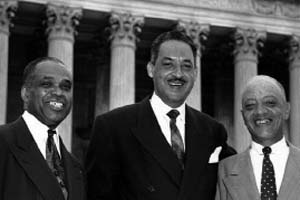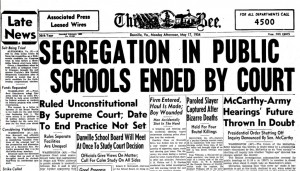In May 1954, the Supreme Court gave their decision regarding school segregation. While the case in Topeka is the most well-known, Brown vs. Board of Education is actually a compilation of 5 cases against school segregation and unequal facilities. Cases from Delaware, Virginia, South Carolina and Washington DC were heard by the Supreme Court along with the Kansas case.
Oliver Brown sued the Topeka school system for requiring his Black child to travel extensively to attend school while white students had the luxury of attending school closer to their homes. When parents tried to enroll their children in the white schools, their children were denied and sent to the Black school. In addition to school segregation, the 13 plaintiffs claimed that the facilities for the Black and white schools were in fact not equal and therefore breaking constitutional law. This inequality, they stated, had detrimental effects on their children’s psyches. The Supreme Court came to a consensus and reversed the constitutionality of “separate but equal” doctrine from Plessy vs. Ferguson (1896). This decision was pivotal in the Civil Rights Movement.
This marked the beginning of the Black community’s efforts towards equal civil rights. There was a cultural lag in the South behind the structural change towards greater equality. Here, CORE was able to step in and further the efforts by staging sit-ins and organizing Freedom Rides. Even with the initiation and spread of Virginia’s Massive Resistance against integration in school, CORE continued to resist the unequal status and assert their rights.

Thurgood Marshall with James Nabrit Jr. and George E.C. Hayes
after their victory in the Brown v. Board of Education case. http://www.pbs.org/jefferson/enlight/brown.htm (date accessed 28 April 2013)

